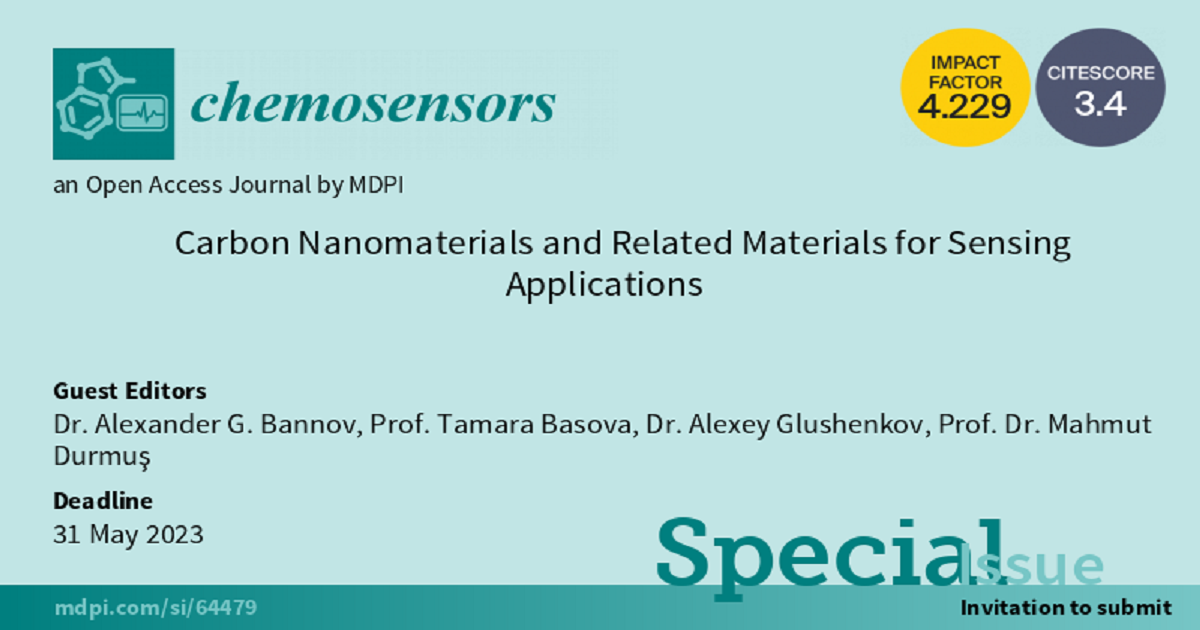Carbon Nanomaterials and Related Materials for Sensing Applications
A special issue of Chemosensors (ISSN 2227-9040). This special issue belongs to the section "Materials for Chemical Sensing".
Deadline for manuscript submissions: closed (31 May 2023) | Viewed by 43226

Special Issue Editors
Interests: gas sensors; carbon nanomaterials; graphene; graphene oxide; ammonia
Special Issues, Collections and Topics in MDPI journals
Interests: optical sensors; chemiresistive sensors; amperometric sensors; gas detection; phthalocyanine thin films; hybrid materials
Special Issues, Collections and Topics in MDPI journals
Interests: electrochemical devices; nanomaterials; transmission electron microscopy
Special Issues, Collections and Topics in MDPI journals
Special Issue Information
Dear Colleagues,
The application of carbon nanomaterials (carbon nanotubes, carbon nanofibers, graphene, graphene oxide, porous carbons, diamond-like carbons, etc.) and related materials for chemical sensing is important due to their unique properties and ability to modify the characteristics of detection of various substances.
This Special Issue will focus on understanding the properties of carbon nanomaterials and their impact on various sensors. In particular, the characteristics of sensors, such as response, sensitivity, selectivity, operating temperature, operating relative humidity, and their interconnection with structure, surface area, chemistry of surface of active materials are of interest. Modification, functionalization, and activation of surface of carbon nanomaterials in order to improve the response and other characteristics is also an urgent problem to be considered in the Special Issue.
In this Special Issue, we invite researchers and authors to submit review articles and original research on Carbon Nanomaterials and Related Materials for Sensing Applications. Potential topics include but are not limited to:
- Carbon nanomaterials and related materials for gas sensors;
- Carbon nanomaterials and related materials for biosensors;
- Carbon nanomaterials and related materials for electrochemical sensors;
- Functionalization of carbon nanomaterials for sensing applications;
- Hybrid materials based on carbon nanomaterials for gas sensors and biosensors;
- Doped carbon nanomaterials for chemical sensing;
- Operating conditions of gas sensors based on carbon nanomaterials;
- Quantum chemical simulation of adsorption processes in hybrid materials.
Dr. Alexander G. Bannov
Prof. Tamara Basova
Dr. Alexey Glushenkov
Prof. Dr. Mahmut Durmuş
Guest Editors
Manuscript Submission Information
Manuscripts should be submitted online at www.mdpi.com by registering and logging in to this website. Once you are registered, click here to go to the submission form. Manuscripts can be submitted until the deadline. All submissions that pass pre-check are peer-reviewed. Accepted papers will be published continuously in the journal (as soon as accepted) and will be listed together on the special issue website. Research articles, review articles as well as short communications are invited. For planned papers, a title and short abstract (about 100 words) can be sent to the Editorial Office for announcement on this website.
Submitted manuscripts should not have been published previously, nor be under consideration for publication elsewhere (except conference proceedings papers). All manuscripts are thoroughly refereed through a single-blind peer-review process. A guide for authors and other relevant information for submission of manuscripts is available on the Instructions for Authors page. Chemosensors is an international peer-reviewed open access monthly journal published by MDPI.
Please visit the Instructions for Authors page before submitting a manuscript. The Article Processing Charge (APC) for publication in this open access journal is 2700 CHF (Swiss Francs). Submitted papers should be well formatted and use good English. Authors may use MDPI's English editing service prior to publication or during author revisions.
Keywords
- gas sensors
- biosensors
- graphene
- carbon nanotubes
- carbon nanomaterials
- graphene-related materials
- sensitivity
- selectivity
Benefits of Publishing in a Special Issue
- Ease of navigation: Grouping papers by topic helps scholars navigate broad scope journals more efficiently.
- Greater discoverability: Special Issues support the reach and impact of scientific research. Articles in Special Issues are more discoverable and cited more frequently.
- Expansion of research network: Special Issues facilitate connections among authors, fostering scientific collaborations.
- External promotion: Articles in Special Issues are often promoted through the journal's social media, increasing their visibility.
- e-Book format: Special Issues with more than 10 articles can be published as dedicated e-books, ensuring wide and rapid dissemination.
Further information on MDPI's Special Issue polices can be found here.







